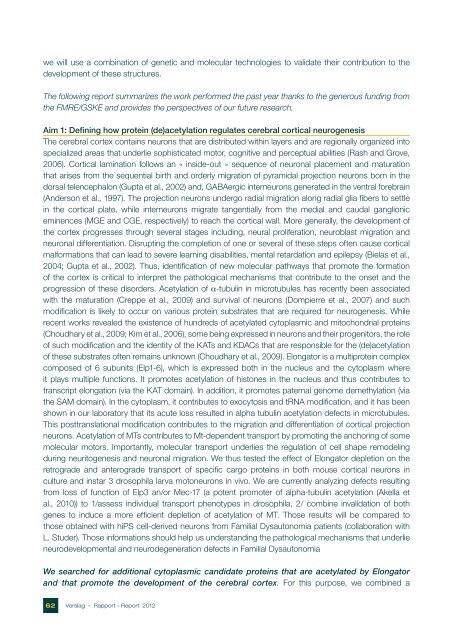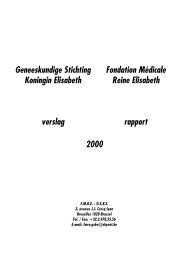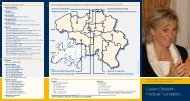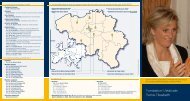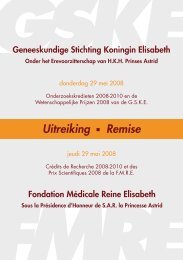Verslag – Rapport – Bericht – Report - GSKE - FMRE
Verslag – Rapport – Bericht – Report - GSKE - FMRE
Verslag – Rapport – Bericht – Report - GSKE - FMRE
Create successful ePaper yourself
Turn your PDF publications into a flip-book with our unique Google optimized e-Paper software.
we will use a combination of genetic and molecular technologies to validate their contribution to the<br />
development of these structures.<br />
The following report summarizes the work performed the past year thanks to the generous funding from<br />
the <strong>FMRE</strong>/<strong>GSKE</strong> and provides the perspectives of our future research.<br />
Aim 1: Defining how protein (de)acetylation regulates cerebral cortical neurogenesis<br />
The cerebral cortex contains neurons that are distributed within layers and are regionally organized into<br />
specialized areas that underlie sophisticated motor, cognitive and perceptual abilities (Rash and Grove,<br />
2006). Cortical lamination follows an « inside-out » sequence of neuronal placement and maturation<br />
that arises from the sequential birth and orderly migration of pyramidal projection neurons born in the<br />
dorsal telencephalon (Gupta et al., 2002) and, GABAergic interneurons generated in the ventral forebrain<br />
(Anderson et al., 1997). The projection neurons undergo radial migration along radial glia fibers to settle<br />
in the cortical plate, while interneurons migrate tangentially from the medial and caudal ganglionic<br />
eminences (MGE and CGE, respectively) to reach the cortical wall. More generally, the development of<br />
the cortex progresses through several stages including, neural proliferation, neuroblast migration and<br />
neuronal differentiation. Disrupting the completion of one or several of these steps often cause cortical<br />
malformations that can lead to severe learning disabilities, mental retardation and epilepsy (Bielas et al.,<br />
2004; Gupta et al., 2002). Thus, identification of new molecular pathways that promote the formation<br />
of the cortex is critical to interpret the pathological mechanisms that contribute to the onset and the<br />
progression of these disorders. Acetylation of a-tubulin in microtubules has recently been associated<br />
with the maturation (Creppe et al., 2009) and survival of neurons (Dompierre et al., 2007) and such<br />
modification is likely to occur on various protein substrates that are required for neurogenesis. While<br />
recent works revealed the existence of hundreds of acetylated cytoplasmic and mitochondrial proteins<br />
(Choudhary et al., 2009; Kim et al., 2006), some being expressed in neurons and their progenitors, the role<br />
of such modification and the identity of the KATs and KDACs that are responsible for the (de)acetylation<br />
of these substrates often remains unknown (Choudhary et al., 2009). Elongator is a multiprotein complex<br />
composed of 6 subunits (Elp1-6), which is expressed both in the nucleus and the cytoplasm where<br />
it plays multiple functions. It promotes acetylation of histones in the nucleus and thus contributes to<br />
transcript elongation (via the KAT domain). In addition, it promotes paternal genome demethylation (via<br />
the SAM domain). In the cytoplasm, it contributes to exocytosis and tRNA modification, and it has been<br />
shown in our laboratory that its acute loss resulted in alpha tubulin acetylation defects in microtubules.<br />
This posttranslational modification contributes to the migration and differentiation of cortical projection<br />
neurons. Acetylation of MTs contributes to Mt-dependent transport by promoting the anchoring of some<br />
molecular motors. Importantly, molecular transport underlies the regulation of cell shape remodeling<br />
during neuritogenesis and neuronal migration. We thus tested the effect of Elongator depletion on the<br />
retrograde and anterograde transport of specific cargo proteins in both mouse cortical neurons in<br />
culture and instar 3 drosophila larva motoneurons in vivo. We are currently analyzing defects resulting<br />
from loss of function of Elp3 an/or Mec-17 (a potent promoter of alpha-tubulin acetylation (Akella et<br />
al., 2010)) to 1/assess individual transport phenotypes in drosophila, 2/ combine invalidation of both<br />
genes to induce a more efficient depletion of acetylation of MT. Those results will be compared to<br />
those obtained with hiPS cell-derived neurons from Familial Dysautonomia patients (collaboration with<br />
L. Studer). Those informations should help us understanding the pathological mechanisms that underlie<br />
neurodevelopmental and neurodegeneration defects in Familial Dysautonomia<br />
We searched for additional cytoplasmic candidate proteins that are acetylated by Elongator<br />
and that promote the development of the cerebral cortex. For this purpose, we combined a<br />
62<br />
<strong>Verslag</strong> <strong>–</strong> <strong>Rapport</strong> <strong>–</strong> <strong>Report</strong> 2012


